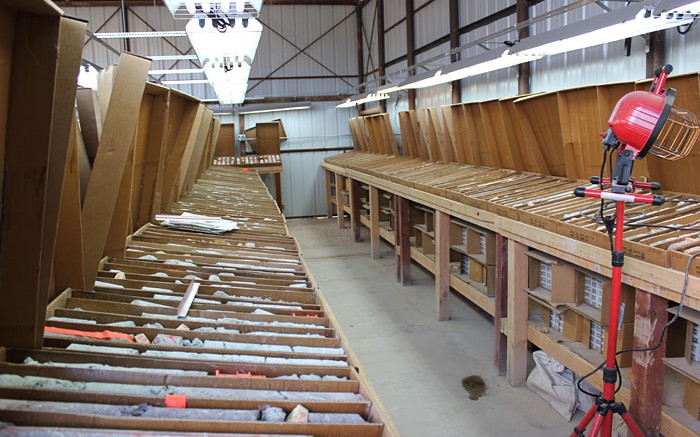VANCOUVER — Good news has been rolling in for explorer Corvus Gold (TSX: KOR) at its wholly owned North Bullfrog gold-silver project, 10 km north of Beatty, Nev. Corvus started a 20,000-metre drill program at the project in mid-May, after having completed an optimized preliminary economic assessment (PEA), and the results have sent the company’s shares skyward.
Corvus has been to following up on twin discoveries from 2012 that could improve the project’s long-term economics, including the high-grade Yellowjacket gold-silver zone and an open-ended zone of disseminated gold mineralization, outside of resource blocks at the Sierra Blanca and North Sierra Blanca deposits.
Mineralization at North Bullfrog occurs in two forms. The first consists of broad, stratabound, bulk-tonnage gold zones, such as the Sierra Blanca and Jolly Jane systems; while the second has moderately thick zones of high-grade gold and silver mineralization hosted in structural feeder zones with breccias and quartz-sulphide vein stockworks, as seen at the Mayflower and Yellowjacket targets.
Drilling at Yellowjacket ventured northward from Corvus’ 2012 discovery hole, tracing 600 metres of potential strike length for a new resource estimate scheduled in early 2014. On Oct. 3 the company reported it had received results from 50-metre-spaced drill fences over 400 metres of strike length, with depths ranging from 150 to 200 metres.
Corvus has found continuity at Yellowjacket and is discovering high-grade veins. Promising drill highlights include: 44 metres grading 2.3 grams gold per tonne from 98 metres depth in hole 13-353; 36 metres of 3.5 grams gold from 113 metres depth in hole 13-354; and 24 metres of 3.5 grams gold from 86 metres depth in hole 13-355.
Gold and silver occur in the intersections as fine grains of electrum, native gold and acanthite, a cyanide-soluble silver sulphide. The company says silver assays are pending on all samples.
“The latest results not only demonstrate the continuity of the Yellowjacket vein system, but also its expansion potential for a large, at-surface, high-grade open-pit deposit, which could offer attractive mining economics,” CEO Jeff Pontius noted.
“We see significant potential to expand this type of high-grade mineralization well beyond the current area drilled. With each new high-grade vein intersection we are building strong support for a major new multi-million ounce, high-grade discovery, with a scale and grade potential similar to the historic Bullfrog mine to the south,” he added.
Meanwhile, Corvus is chasing northern and western extensions at its Sierra Blanca deposit, which could provide more mill feed to any potential open-pit operation on Yellowjacket. Mineralization at Sierra Blanca tends to be disseminated and lower grade, but its near-surface and heap-leach potential hint at positive effects on North Bullfrog’s economics.
Drilling at Sierra Blanca is cutting shallow oxide mineralization, including grades higher than those used in Corvus’ most recent PEA. On Oct. 2 the company announced it had hit mineralization between Yellowjacket and Sierra Blanca when it received results from holes collared around the northern flank of the Sierra Blanca ridge.
Highlights from stepout drilling around Sierra Blanca are: 47 metres grading 0.36 gram gold and 1.34 grams silver from 87 metres depth in hole 13-233; 41 metres of 0.39 gram gold and 0.77 gram silver from surface in hole 13-238; and 47 metres averaging 0.26 gram gold and 0.76 gram silver from 11 metres depth in hole 13-240. All holes encountered bulk-tonnage, low-grade oxide mineralization common in the Sierra Blanca deposit.
“The fact that we continue to hit new mineralized structures over and over again, many with potential for high-grade vein discoveries, confirms that we have really only scratched the surface with our first systematic, high-grade drilling campaign,” Pontius said. “North Bullfrog is demonstrating significant expansion potential for the large, at-surface, low-grade system and the high-grade Bullfrog-type systems, all with anticipated high heap-leach recoveries.”
Drilling along Sierra Blanca’s western extent has also revealed exploration upside. In early September Corvus released results showing that the deposit could be expanded westwards. The company pointed to hole 13-227 — collared in alluvial cover 100 metres west of the current Sierra Blanca deposit — which cut 38 metres grading 0.47 gram gold and 0.71 gram silver from 17 metres down hole.
The drilling has fuelled a rally in Corvus’ shares over the past three months. Since late June shares have jumped 109%, or 60¢ per share.
Corvus traded within a 52-week window of 51¢ to $1.83, and closed at $1.15 per share at press time.
The company has 65.2 million shares outstanding for a $78-million market capitalization.
Corvus reported $7.9 million in cash and equivalents at the end of May after closing a $7.2-million strategic private placement with Tocqueville Asset Management and AngloGold Ashanti (NYSE: AU) in April. The company issued 8.3 million shares at 87¢ per share.


Be the first to comment on "Corvus rallies on Bullfrog drill results"